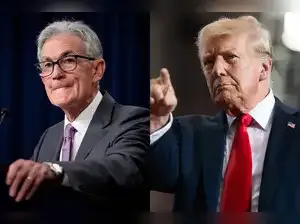Powell hints at first Fed rate cut since December: Federal Reserve Chair Jerome Powell sparked a surge in U.S. stocks on Friday after suggesting that the Fed could soon lower interest rates, potentially as early as next month. The move would mark the first rate cut since December, giving markets a clear signal of a more dovish monetary stance.
Jerome Powell's recent remarks at the Jackson Hole Economic Symposium have ignited discussions about a potential interest rate cut at the upcoming Federal Open Market Committee (FOMC) meeting on September 16-17.
Investors reacted swiftly. The Dow Jones Industrial Average jumped more than 800 points, while the S&P 500 rose 1.68% and the Nasdaq climbed 2.1%. Each index was poised for its largest single-day gain since May, with the Dow on track to close at its first record high of the year.
ALSO READ: Crypto spikes after Powell dovish shock — BTC, ETH, LTC surge, is momentum finally here?
The Fed chair’s comments come amid heightened scrutiny from the Trump administration, which has called for a complete overhaul of the central bank.
One governor resigned this month, and Trump publicly criticized Powell for not lowering rates sooner. Despite these pressures, Powell framed any potential rate cut as a response to economic fundamentals, not political influence.
ALSO READ: US stocks surge: Dow, S&P, Nasdaq jump on Powell’s Fed rate cut signal — a short-term spike or long-term rally?
Powell’s dovish tone at the forum gave markets a clear catalyst, easing uncertainty about the Fed’s next moves and contributing to a sharp drop in the CBOE Volatility Index, Wall Street’s fear gauge, by 12%.
While Powell acknowledged the possibility of such a move, he emphasized that any decision would be based on forthcoming economic data, particularly concerning employment and inflation.
Despite these pressures, Powell reiterated the Fed's commitment to making decisions based solely on economic data, emphasizing the importance of maintaining the central bank's independence. He stated that the Fed would "proceed carefully" and that the "baseline outlook and the shifting balance of risks may warrant adjusting our policy stance."
The Fed will consider upcoming August jobs and inflation data before the September meeting to decide on potential rate cuts.
Q2: How will a Fed rate cut affect the economy?
Lower rates could reduce borrowing costs, boost investments, and influence inflation, directly affecting consumers and markets.
Jerome Powell's recent remarks at the Jackson Hole Economic Symposium have ignited discussions about a potential interest rate cut at the upcoming Federal Open Market Committee (FOMC) meeting on September 16-17.
Investors reacted swiftly. The Dow Jones Industrial Average jumped more than 800 points, while the S&P 500 rose 1.68% and the Nasdaq climbed 2.1%. Each index was poised for its largest single-day gain since May, with the Dow on track to close at its first record high of the year.
Economic risk—not Trump pressure—drives potential rate cut
Powell emphasized that the possibility of a rate cut is driven by growing economic risks, particularly in the labor market, rather than pressure from President Donald Trump. The jobs report released earlier this month showed a slowdown in payroll growth, raising concerns about the resilience of the U.S. labor market.ALSO READ: Crypto spikes after Powell dovish shock — BTC, ETH, LTC surge, is momentum finally here?
The Fed chair’s comments come amid heightened scrutiny from the Trump administration, which has called for a complete overhaul of the central bank.
One governor resigned this month, and Trump publicly criticized Powell for not lowering rates sooner. Despite these pressures, Powell framed any potential rate cut as a response to economic fundamentals, not political influence.
ALSO READ: US stocks surge: Dow, S&P, Nasdaq jump on Powell’s Fed rate cut signal — a short-term spike or long-term rally?
Jackson Hole conference underscores market focus
The annual Jackson Hole Economic Policy Symposium in Wyoming, where Powell delivered his remarks, continues to be a key event for global central bankers and investors.Powell’s dovish tone at the forum gave markets a clear catalyst, easing uncertainty about the Fed’s next moves and contributing to a sharp drop in the CBOE Volatility Index, Wall Street’s fear gauge, by 12%.
Fed leadership and political backdrop
While Powell’s term ends in May 2026, the Trump administration is actively considering potential successors. Treasury Secretary Scott Bessent is leading the search, with several candidates under consideration, including:- Fed Governor Christopher Waller and Vice Chair Michelle Bowman, who dissented in favor of a rate cut at the July Fed meeting
- Former Fed governors Kevin Warsh and James Bullard
- Dallas Fed President Lorie Logan and economist Marc Sumerlin
- Even former Treasury Secretary Janet Yellen has been discussed
Market implications and investor sentiment
Wall Street welcomed Powell’s dovish signals. Analysts noted that the rate cut possibility aligns with concerns about slowing labor market growth, while providing some relief to markets anxious about Trump’s trade policies and tariffs.- Dow Jones surged nearly 900 points, hitting a new intraday record
- S&P 500 climbed 1.68%
- Nasdaq gained 2.1%
Key economic reports ahead
Powell’s plan is not set in stone. Several major reports will influence the Fed’s next move before the September 16-17 meeting:- August Jobs Report (released first Friday of September) – A strong rebound in hiring or a lower unemployment rate could reduce the need for a September rate cut.
- Consumer and Producer Price Index reports for August – If inflation remains elevated, expectations for a cut may need recalibration.
While Powell acknowledged the possibility of such a move, he emphasized that any decision would be based on forthcoming economic data, particularly concerning employment and inflation.
Political Pressures and Fed Independence
President Donald Trump has been vocal in his criticism of the Federal Reserve's monetary policy, urging for aggressive rate cuts to stimulate economic growth. In recent months, he has called for the resignation of Fed officials and has threatened to remove Chair Powell.Despite these pressures, Powell reiterated the Fed's commitment to making decisions based solely on economic data, emphasizing the importance of maintaining the central bank's independence. He stated that the Fed would "proceed carefully" and that the "baseline outlook and the shifting balance of risks may warrant adjusting our policy stance."
Implications for the Economy and Financial Markets
A potential rate cut by the Federal Reserve could have several implications:- Borrowing Costs: Lower interest rates may reduce borrowing costs for consumers and businesses, potentially stimulating spending and investment.
- Inflation: While a rate cut could support economic growth, it may also exert upward pressure on inflation if demand increases without a corresponding rise in supply.
- Financial Markets: Equity markets may continue to benefit from lower rates, as investors seek higher returns. However, bond markets could face challenges if inflation expectations rise.
FAQs:
Q1: When will the Federal Reserve decide on rate cuts?The Fed will consider upcoming August jobs and inflation data before the September meeting to decide on potential rate cuts.
Q2: How will a Fed rate cut affect the economy?
Lower rates could reduce borrowing costs, boost investments, and influence inflation, directly affecting consumers and markets.








